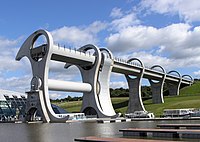
Photo from wikipedia
NASA's Mars Science Laboratory Curiosity rover landed in August 2012 and began experiencing higher rates of wheel damage beginning in October 2013. While the wheels were designed to accumulate considerable… Click to show full abstract
NASA's Mars Science Laboratory Curiosity rover landed in August 2012 and began experiencing higher rates of wheel damage beginning in October 2013. While the wheels were designed to accumulate considerable damage, the unexpected damage rate raised concerns regarding wheel lifetime. In response, the Jet Propulsion Laboratory developed and deployed mobility flight software on Curiosity that reduces the forces on the wheels. The new algorithm adapts each wheel's speed to fit the terrain topography in real time, by leveraging the rover's measured attitude rates and rocker/bogie suspension angles and rates. Together with a rigid‐body kinematics model, it estimates the real‐time wheel‐terrain contact angles and commands idealized, no‐slip wheel angular rates. In addition, free‐floating “wheelies” are detected and autonomously corrected. Ground test data indicate that the forces on the wheels are reduced by 19% for leading wheels and 11% for middle leading wheels. On the ground, the required data volume increased by up to 129%, and drive duration increased by up to 25%. In flight, data collected over 3.6 km and 149 drives confirmed a reduction in wheel current, correlated with wheel torque, of 18.7%. The new algorithm proved to use fewer resources in flight than ground estimates suggested, as only a 10% increase in drive duration and double the drive data volume were experienced. These data indicate the promise of the new algorithm to extend the life of the wheels for the Curiosity rover. This paper describes the algorithm, its ground testing campaign and associated challenges, and its validation, implementation, and performance in flight.
Journal Title: Journal of Field Robotics
Year Published: 2020
Link to full text (if available)
Share on Social Media: Sign Up to like & get
recommendations!